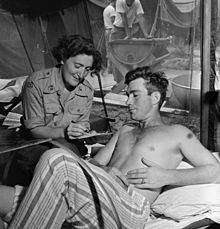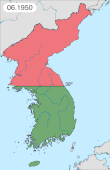Medical support in the Korean War
During the Korean War, six countries—Sweden, India, Denmark, Norway, Italy, and West Germany—provided medical support to South Korea and the United Nations Forces.
Following the North Korean invasion, the UN Security Council adopted a resolution asking all UN member states to support South Korea.
[citation needed] Shortly before his death, King Gustaf V announced that the Swedish state would cover the hospital's expenses.
[5][6][7] A small advisory group from Sweden stayed in Korea to advise on medical practices until autumn 1958.
Sweden was the first Western European country to establish diplomatic relations and an embassy in North Korea.
The 60th Parachute Field Ambulance (60th PFA), commanded by Lieutenant Colonel A. G. Rangaraj, arrived on 20 November 1950 and began to operate on 6 December 1950 at the Pyongyang front.
Indian Army officer—Colonel M. K..Unni Nayar, part of the United Nations Korea Committee, died on 12 August 1950 when he was killed in a mine accident.
The route from Stavanger to Tokyo ran via Munich, Nice, Naples, Beirut, Cairo, Karachi, Calcutta, Bangkok and Hong Kong.
They arrived in South Korea on 22 June and NORMASH was first established at Uijongbu, approximately 12 miles north of Seoul, on 19 July.
In total, NORMASH treated 90,000 patients, of which the largest groups were the U.S. (36%), South Korea (33%) and the various British and Commonwealth troops (27%).
With the signing of the Armistice Agreement on 27 July 1953, the hospital stopped receiving wounded soldiers, but continued to treat substantial number of Korean civilians.
[22] The Italian Red Cross supported this hospital with personnel from the Military Corps (Corpo Militare della Croce Rossa Italiana) and the Volunteer Nurses Corps (Corpo delle Infermiere Volontarie della Croce Rossa Italiana).
[26][27] The hospital opened on 17 May in Busan with 80 personnel[28][29] and closed nearly five years later on 14 March 1959, with a total of 200 Germans having treated about 2,400,000 civilians.








Chinese and
Soviet forces
• South Korean, U.S.,
Commonwealth
and United Nations
forces